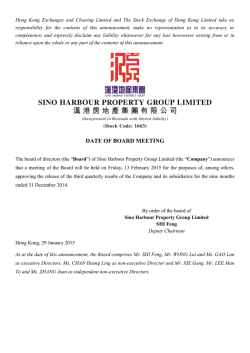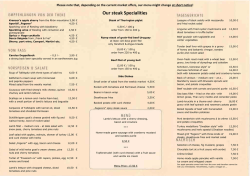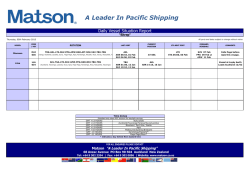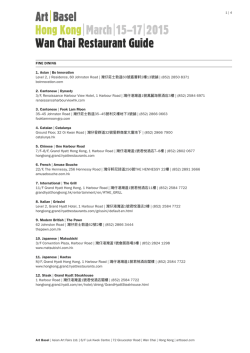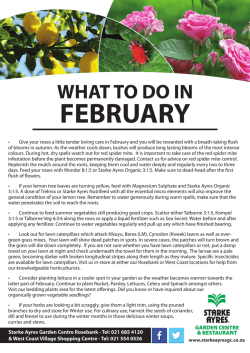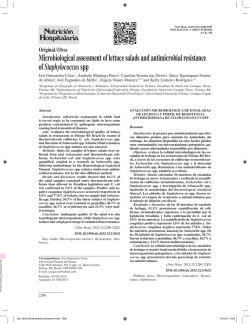
Bay of Plenty Regional Council: Home
TAURANGA HARBOUR FACTSHEET 1 Sea lettuce What is sea lettuce? Sea lettuce is a naturally occurring green algae that is native to New Zealand. It grows in sheets, and in Tauranga Harbour its large blooms can be a nuisance to people, water craft and structures and affect other animals and plants. Sea lettuces are collectively grouped under the category of Ulva species. Ulva is a macrophyte algae which grows in sheets two cells thick usually less than 30cm in length. Ulva is rich in compounds such as vitamin A and B. Early Maori used the completely edible sea lettuce in cooking. Sea lettuce are still eaten today in salads and stews around the world. Fish, such as parore, feed on sea lettuce. Why is it a problem? Nuisance blooms of sea lettuce can affect the way our harbours and estuaries look, and peoples use of the harbour for business and pleasure. Wave action or tidal currents cause the sea lettuce to break off from its growth beds and be washed ashore where it rots. The smell can be offensive because of the high sulphur content of sea lettuce. Over summer months during some years, depending on wind and tides, sea lettuce can be deposited on beach and foreshore areas in large quantities. When the sea lettuce drifts around the harbour it can interfere with fishing nets and lines. It can also affect commercial shipping at the Port of Tauranga, blocking cooling water intakes. It can also smother shellfish beds when it accumulates in large quantities during nuisance blooms. Why does it grow here? The clear, shallow waters of the Tauranga Harbour, Maketu Estuary and Little Waihi Estuary provide an ideal habitat for sea lettuce. Normally, the amount of nutrients in our harbours and estuaries is low, slowing sea lettuce growth. However large blooms do happen regularly in New Zealand and in temperate coastal waters of countries throughout the world. Are the blooms telling us that something’s wrong in the harbour? The research Environment Bay of Plenty has done shows that the sea lettuce blooms in Tauranga Harbour are a natural event and are not the result of pollution. They match the El Nino weather pattern, when persistent westerly winds drive coastal water offshore. In these conditions the deeper oceanic water up-wells, to replace the coastal water, bringing with it nutrient rich water which then enters the estuaries. It’s this increase of nutrients that is the main cause of the blooms. The facts • Sea lettuce is a native algae • It can be eaten • Studies show its occurrence is a natural event • The abundance of sea lettuce in Tauranga Harbour is monitored every two months • Sea lettuce blooms are linked to climatic conditions • Nuisance bloom events occur periodically over summer months • Bloom events can have undesirable effects on marine life and recreation • You can find out more about sea lettuce by visiting www.envbop.govt.nz TAURANGA HARBOUR FACTSHEET Where can I get more information? The sea lettuce monitoring reports and research are available on Environment Bay of Plenty’s website www.envbop.govt.nz. For more information contact… Environment Bay of Plenty Phone: 0800 ENV BOP (368 267) Correlation between Southern Oscillation Index (El Nino) and sea lettuce abundance (top graph) and sea lettuce cover (bottom graph) in Tauranga Harbour between 1991 and 2007. When the SOI Index is negative, sea lettuce is more abundant. The bottom graph is inverted in the top graph to show this correlation. Are the blooms being checked? Environment Bay of Plenty has been monitoring sea lettuce growth since 1991 and has done extensive research into how it grows. The regional council checks the harbour every two months, getting data on sea lettuce abundance, the level of nutrients in the harbour and other environmental factors that could be influencing blooms in Tauranga Harbour. Is anything being done to get rid of the blooms? Because it is a natural occurence that is largely driven by uncontrollable factors, sea lettuce clean up can be impractical. Environment Bay of Plenty monitors and provides information on sea lettuce. Tauranga City Council can help residents collect sea lettuce from the beaches in its local authority area, and funds clean up works next to harbour reserves after large blooms. You can contact them for more information about the assistance that is available. Western Bay of Plenty District Council does not currently do any sea lettuce removal as the impact is not great in its area. Any organisation or individual can remove sea lettuce from beaches or the foreshore on behalf of the community, but they must get the correct permission from the Ministry of Fisheries. Commercial harvesting of sea lettuce may also require resource consent from Environment Bay of Plenty. Can sea lettuce be used for anything? Research by Tauranga City Council shows that sea lettuce can be used as a compost and fertiliser, but needs to be mixed with other materials before it is used. Tauranga City Council Phone: 07 577 7000 Western Bay of Plenty District Council Phone: 07 571 8008
© Copyright 2025

